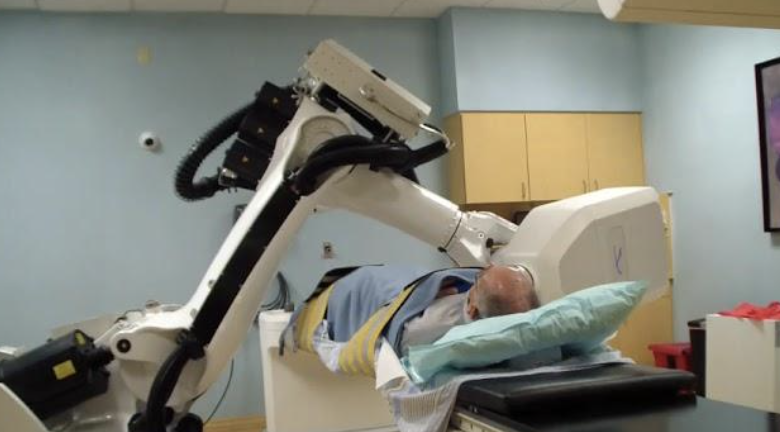What is CyberKnife? CyberKnife is a brand name for a device that delivers stereotactic body radiation therapy (SBRT). It’s a form of external beam radiation. It can be used to treat prostate cancer and other types of cancer.
Although it contains the word “knife” and is referred to as “radiosurgery,” there’s no knife or incision.
Click the link to see a time lapse video of CyberKnife Treatment underway for prostate cancer on our YouTube Channel https://youtu.be/WatEVNaa3zA
SBRT is an image-guided technique of delivering high doses of radiation with extreme accuracy. The purpose is to kill cancer cells while limiting damage to healthy tissues and organs.
The CyberKnife system has continual image guidance software that works in real time to adjust to your breathing cycle and tumor movement. SBRT allows for large doses in a specified area, so you can complete your treatment in a few days. By comparison, conventional radiation therapy takes as long as nine weeks to complete.
Who is a candidate for CyberKnife? CyberKnife can be used as a first-line treatment for early-stage prostate cancer. It can be combined with hormone therapy for cancer that has spread into nearby tissues. It can also be used to slow progression in advanced cancer or cancer that has recurred after previous treatment.
CyberKnife vs. Traditional Treatments: Prostate cancer treatment is not the same for everyone. Surgery, radiation therapy, chemotherapy, and hormone therapy are designed to do different things.
CyberKnife Benefits Compared to Other Treatments:
• There’s no incision or pain, as you might have from surgery.
• There’s no need for anesthesia or a hospital stay.
• As soon as it’s over, you get up and return to your normal activities.
• It’s a lot less time-consuming than conventional radiation or chemotherapy.
• There’s no extended recovery period.
Another type of radiation used for prostate surgery is brachytherapy. It involves implanting radioactive pellets in your prostate. The pellets release radiation over a period of days or weeks. It’s a good option for early-stage or low-grade prostate cancer. CyberKnife may be a better choice if you can’t have anesthesia or if your anatomy makes brachytherapy difficult.
If you have treatment with CyberKnife, you may need other therapies as well. Your doctor will make a recommendation based on variables such as the stage and grade of the cancer, as well as your age and any other health conditions you may have.
How do you prepare for CyberKnife? You’ll need to go through a few steps before treatment can begin.
With ultrasound as a guide, a urologist will use long needles to place gold markers in your prostate. This will be similar to when you had your biopsy. CyberKnife will use the markers to track the tumor during treatment.
Then you’ll need some imaging tests to assess the location, size, and shape of the tumor. This data is sent to the CyberKnife software, so the proper dose, exact location, and number of treatments can be determined.
You’ll likely need one to five treatments, all on an outpatient basis.
There’s no need for anesthesia or other medications, so you can eat and take medications as usual. Avoid lotions and powders on the area to be treated, and wear comfortable clothing. No further preparation is needed.
What happens during the procedure? You’ll be placed in the proper position on a table. Then, a computer-controlled robot will move slowly around the table, targeting radiation where it’s needed. The software will adjust radiation for your breathing pattern and any movement of the tumor.
This is a noninvasive, painless procedure. Each session will last anywhere from 30 to 90 minutes.
Side effects of SBRT are similar to those of other types of radiation treatment for prostate cancer, such as:
• urinary problems
• rectal irritation
• erectile dysfunction
• fatigue
These side effects are usually temporary.
What happens after treatment? Your doctor will advise you on a follow-up schedule of visits. A few months after treatment, you’ll probably need to schedule new imaging tests, such as CT, MRI, or PET. The images will help your doctor evaluate your response to radiation treatment.
If no cancer can be found, you may not need further treatment. You’ll need careful monitoring for some time, though. That usually involves routine physical exams, PSA testing, and imaging tests to check for signs of recurrence.
If there’s still evidence of cancer after SBRT, your doctor will make some recommendations on the next steps.
Takeaway: SBRT is considered safe and effective. It’s less time-consuming than some other types of radiation therapy. CyberKnife may not be available at all treatment centers. Ask your doctor if SBRT with CyberKnife is a good choice for you.
If you want to talk to the top CyberKnife Experts in Miami call the CyberKnife Center of Miami. We will answer all your questions and help determine if it is the best treatment option for you ~ 305-279-2900 and go to our prostate cancer website for more information on how we treat prostate cancer with CyberKnife.

